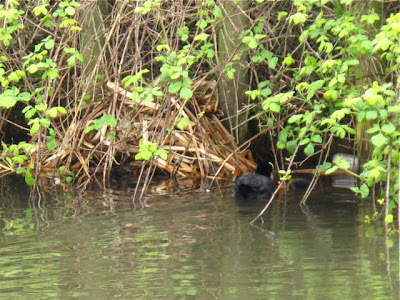A second visit to East Park this April. The weather held on and we didn't have rain. Things have moved on fast since my last visit. There were at least 10 occupied coot nests, at least one with chicks. I could see three Great Crested Grebes, one of them was on its nest, and judging by their position of the others in the lake, I think there might be three territories. At least two sets of ducklings were present. House Sparrows were very visible, as they were busy hunting insects in mid air, flycatcher-style, they probably already have chicks on their nests.
The highlight was the strong passage of House Martins, many individuals chirping, which were joined by many Swallows, which were everywhere feeding low over the lake. A group of Swallows had stopped for a grooming session on a roof.
A group of around 20 Crows descended upon us, on realising we had some bread. They were shy and didn't like to get too close, and filled their beak pouches with the bread. Outside roosts, I've never seen so many Carrion Crows together.
Several Blackcaps and Chiffchaffs were singing.
Coot feeding two fledglings beside their nest
A scene from "The Birds"? no! just East Park on a Monday morning
This one couldn't possibly tuck any more bread in its beak pouch
Great Crested Grebe nest tucked next to the bank of one of the islands
Swallows resting on roof
Bird list- Blackbird, S
- Blackcap, S
- Blue Tit, S
- Canada Goose, pair
- Carrion Crow
- Chaffinch, S
- Chiffchaff, S
- Collared Dove
- Coot, FL
- Dunnock, S
- Feral Pigeon
- Goldfinch, S
- Great Crested Grebe, 3, ON
- Great Spotted Woodpecker, pair
- Great Tit, S
- Greenfinch
- Greylag Goose
- Herring Gull, 2
- House Martin, c20
- House Sparrow, FF
- Lesser Black-backed Gull, 2
- Magpie
- Mallard, FL
- Mistle Thrush, S
- Moorhen
- Mute Swan, 1
- Pied Wagtail
- Robin, S
- Sparrowhawk
- Starling, B
- Swallow
- Tufted Duck
- Woodpigeon
- Wren, S







































